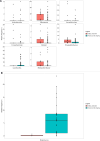Influence of ESBL colonization status on gut microbiota composition during allogenic hematopoietic stem cell transplantation
- PMID: 39779737
- PMCID: PMC11711636
- DOI: 10.1038/s41598-025-85128-6
Influence of ESBL colonization status on gut microbiota composition during allogenic hematopoietic stem cell transplantation
Abstract
After allogeneic HSCT (allo-HSCT), the diversity of the intestinal microbiota significantly decreases. The changes can be rapid and are thought to be caused by chemotherapy, antibiotics, or intestinal inflammation. Most patients are exposed to prophylactic and therapeutic antibiotics during neutropenia and several patients are colonized by ESBL bacteria. We investigated the changes in gut microbiota composition in allo-HSCT, aiming at investigating if the acquisition of ESBL colonization may affect gut microbiome diversity during allo-HSCT. This was a single-center prospective pilot study. All patients consecutively admitted to the Haematological Unit of the City of Health and Science, Molinette Hospital in Turin, Italy, and undergoing allo-HSCT between August 2017 to August 2020 were enrolled in the study. Microbiome analysis on fecal samples were collected every 7 days from hospital admission to discharge and until 1 year after HSCT. 48 patients were enrolled in the study. At baseline 14 patients (29.16%) were colonized by MDR bacteria, mostly extended-spectrum beta-lactamase (ESBL)-producing gram negatives (N = 11; 78.57%). During allo-HSCT, one patient had a positive rectal swab for a carbapenemase-producing Klebsiella pneumoniae and eight patients lost the colonization during the hospital stay. Microbiota composition was compared between patients colonized by ESBL at baseline and non-colonized patients. Patients colonized by ESBL had a greater abundances of Bifidobacterium, Blautia, Clostridium, Coprococcus, L-Ruminococcus Mogibacteriaceae, Peptostreptococceae and Oscillospira, while non-colonized ESBL patients had a greater abundance of Actinomycetales, Staphylococcus and Sutterella. Moreover, microbiota composition of colonized by ESBL that retained colonization after HSCT showed an increased in abundances of Akkermansia, Dialister, Erysipelotrichaceae and Methanobrevibacter when compared with patients that become negative at rectal swabs. From a clinical perspective, the evolution of this prospective pilot study will be to investigate markers of gut barrier functions, SCFA productions and to correlate the predictivity of these parameters with risk of invasive infections and clinical outcomes in allo-HSCT population.
Keywords: Allo-HSCT; ESBL; MDR; Microbiome.
© 2025. The Author(s).
Conflict of interest statement
Competing interests: The authors declare no competing interests.
Figures




Similar articles
-
Alteration of Gut Microbiota Composition and Diversity in Acute and/or Chronic Graft-versus-Host Disease Following Hematopoietic Stem Cell Transplantation: A Prospective Cohort Study.Int J Mol Sci. 2024 May 26;25(11):5789. doi: 10.3390/ijms25115789. Int J Mol Sci. 2024. PMID: 38891979 Free PMC article.
-
Colonization With Levofloxacin-resistant Extended-spectrum β-Lactamase-producing Enterobacteriaceae and Risk of Bacteremia in Hematopoietic Stem Cell Transplant Recipients.Clin Infect Dis. 2018 Nov 13;67(11):1720-1728. doi: 10.1093/cid/ciy363. Clin Infect Dis. 2018. PMID: 29701766 Free PMC article.
-
Gut Colonization by ESBL-Producing Escherichia coli in Dogs Is Associated with a Distinct Microbiome and Resistome Composition.Microbiol Spectr. 2023 Aug 17;11(4):e0006323. doi: 10.1128/spectrum.00063-23. Epub 2023 Jul 5. Microbiol Spectr. 2023. PMID: 37404183 Free PMC article.
-
Gut microbiota injury in allogeneic haematopoietic stem cell transplantation.Nat Rev Cancer. 2018 May;18(5):283-295. doi: 10.1038/nrc.2018.10. Epub 2018 Feb 16. Nat Rev Cancer. 2018. PMID: 29449660 Free PMC article. Review.
-
The clinical role of the gut microbiome and fecal microbiota transplantation in allogeneic stem cell transplantation.Haematologica. 2021 Apr 1;106(4):933-946. doi: 10.3324/haematol.2020.247395. Haematologica. 2021. PMID: 33241674 Free PMC article. Review.
Cited by
-
A case of Severe Gastrointestinal Toxicity after Allogeneic Hematopoietic Stem Cell Transplantation: Can We Improve the Evaluation of the "Gut Fitness"?Mediterr J Hematol Infect Dis. 2025 Jul 1;17(1):e2025054. doi: 10.4084/MJHID.2025.054. eCollection 2025. Mediterr J Hematol Infect Dis. 2025. PMID: 40636281 Free PMC article. No abstract available.
References
-
- O’Toole, P. W. & Jeffery, I. B. Gut microbiota and aging. Science350, 1214–1215 (2015). - PubMed
Publication types
MeSH terms
Substances
Grants and funding
LinkOut - more resources
Full Text Sources

